Biermann Ch. Handbook of Pulping and Papermaking
Подождите немного. Документ загружается.

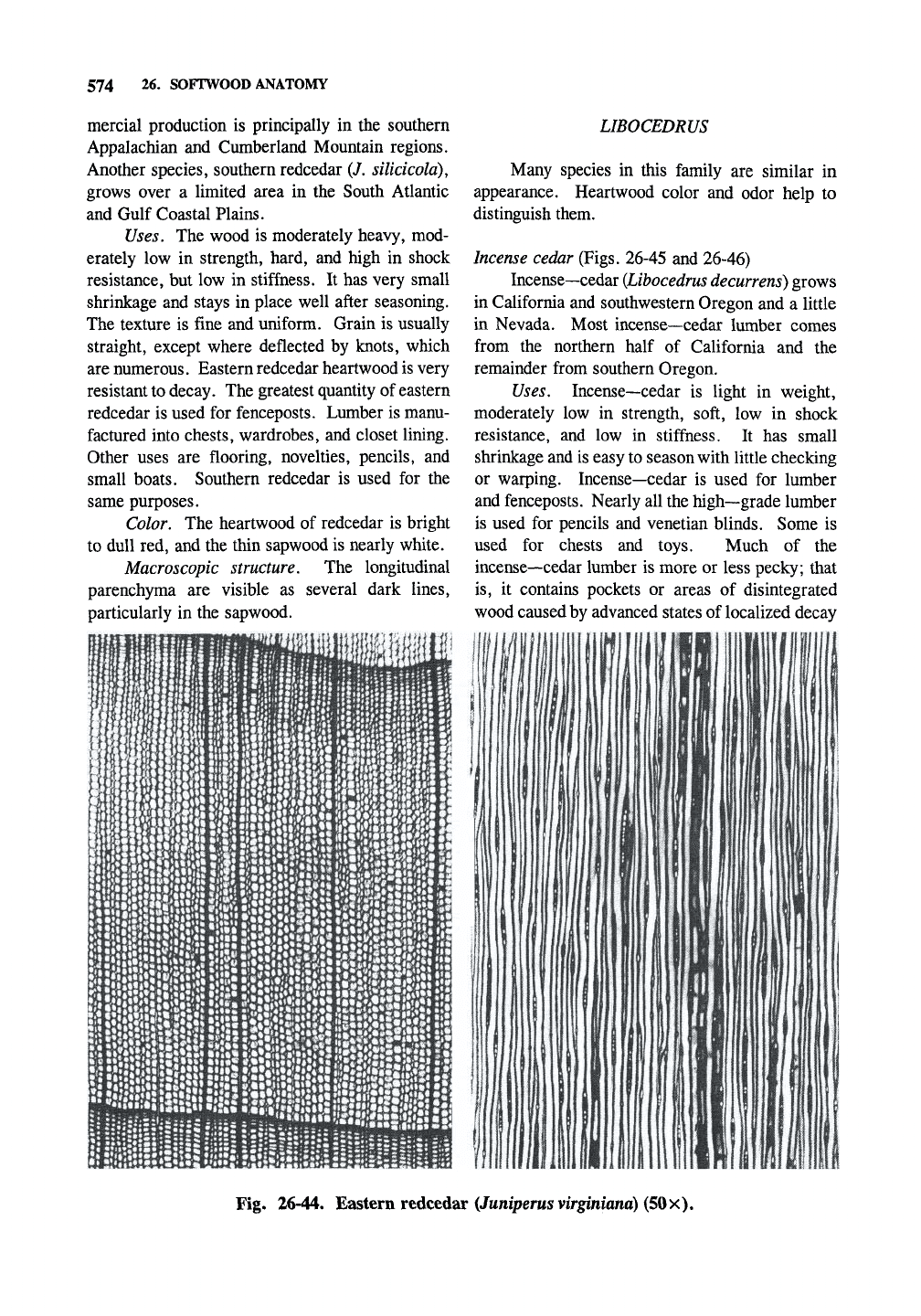
574 26. SOFTWOOD ANATOMY
mercial production is principally in the southern
Appalachian and Cumberland Mountain regions.
Another species, southern redcedar (J. silicicold),
grows over a limited area in the South Atlantic
and Gulf Coastal Plains.
Uses. The wood is moderately heavy, mod-
erately low in strength, hard, and high in shock
resistance, but low in stiffness. It has very small
shrinkage and stays in place well after seasoning.
The texture is fine and uniform. Grain is usually
straight, except where deflected by knots, which
are numerous. Eastern redcedar heartwood is very
resistant to decay. The greatest quantity of eastern
redcedar is used for fenceposts. Lumber is manu-
factured into chests, wardrobes, and closet lining.
Other uses are flooring, novelties, pencils, and
small boats. Southern redcedar is used for the
same purposes.
Color. The heartwood of redcedar is bright
to dull red, and the thin sapwood is nearly white.
Macroscopic structure. The longitudinal
parenchyma are visible as several dark lines,
particularly in the sapwood.
LIBOCEDRUS
Many species in this family are similar in
appearance. Heartwood color and odor help to
distinguish them.
Incense cedar (Figs. 26-45 and 26-46)
Incense—cedar
(Libocedrus
decurrens) grows
in California and southwestern Oregon and a little
in Nevada. Most incense—cedar lumber comes
from the northern half of California and the
remainder from southern Oregon.
Uses. Incense—cedar is light in weight,
moderately low in strength, soft, low in shock
resistance, and low in stiffness. It has small
shrinkage and is easy to season with little checking
or warping. Incense—cedar is used for lumber
and fenceposts. Nearly all the high—grade lumber
is used for pencils and Venetian blinds. Some is
used for chests and toys. Much of the
incense—cedar lumber is more or less pecky; that
is,
it contains pockets or areas of disintegrated
wood caused by advanced states of localized decay
Fig. 26-44. Eastern redcedar (Jii/iiperiisvirgimana) (50X).
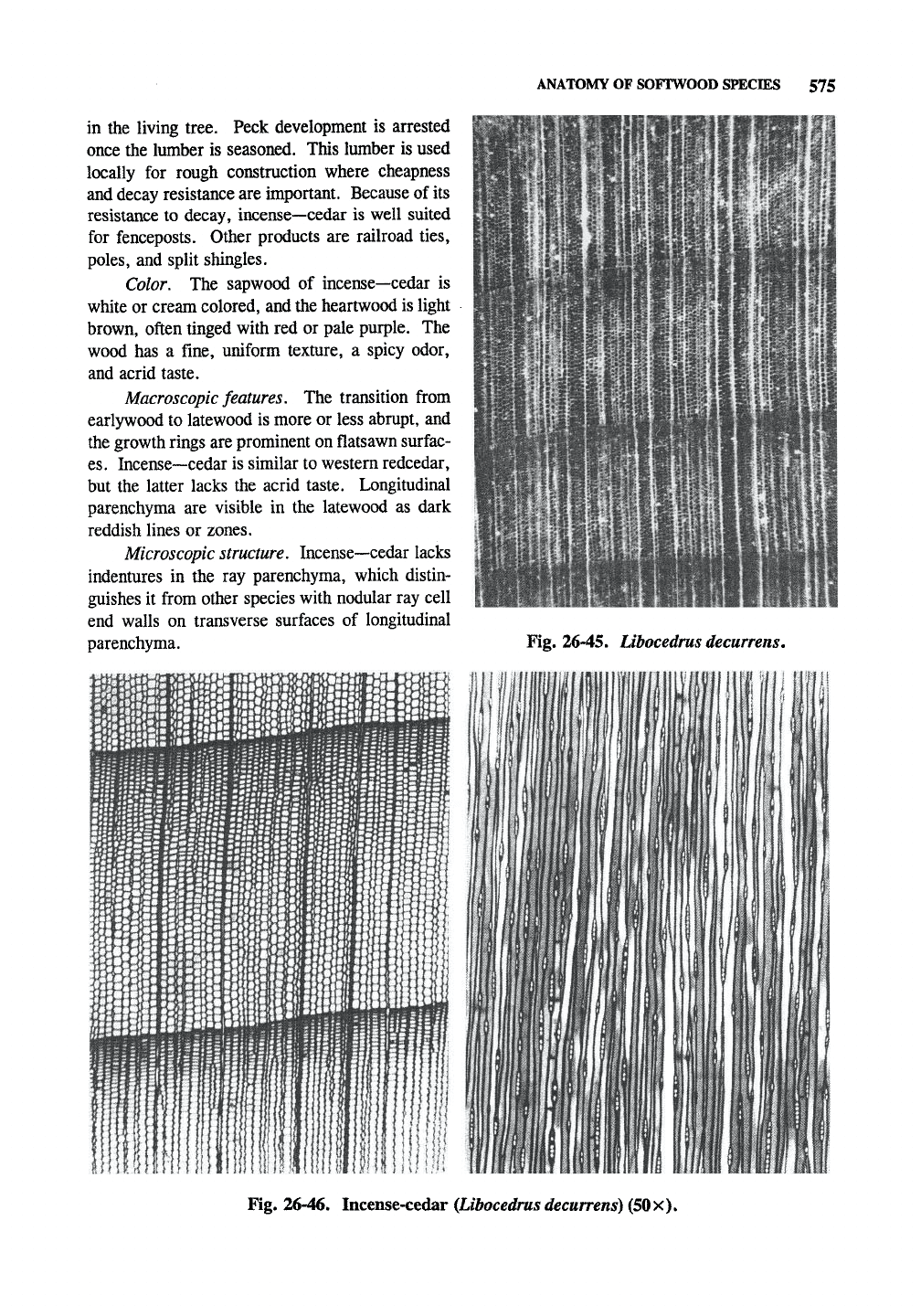
ANATOMY OF SOFTWOOD SPECIES 575
in the living tree. Peck development is arrested
once the lumber is seasoned. This lumber is used
locally for rough construction where cheapness
and decay resistance are important. Because of its
resistance to decay, incense—-cedar is well suited
for fenceposts. Other products are railroad ties,
poles,
and split shingles.
Color. The sapwood of incense—cedar is
white or cream colored, and the heartwood is light
brown, often tinged with red or pale purple. The
wood has a fine, uniform texture, a spicy odor,
and acrid taste.
Macroscopic features. The transition from
earlywood to latewood is more or less abrupt, and
the growth rings are prominent on flatsawn surfac-
es.
Incense—cedar is similar to western redcedar,
but the latter lacks the acrid taste. Longitudinal
parenchyma are visible in the latewood as dark
reddish lines or zones.
Microscopic structure. Incense—cedar lacks
indentures in the ray parenchyma, which distin-
guishes it from other species with nodular ray cell
end walls on transverse surfaces of longitudinal
parenchyma.
Fig. 26-45. Libocedrus decurrens.
Fig. 26-46. Incense-cedar (Libocedrus decurrens) (50X).
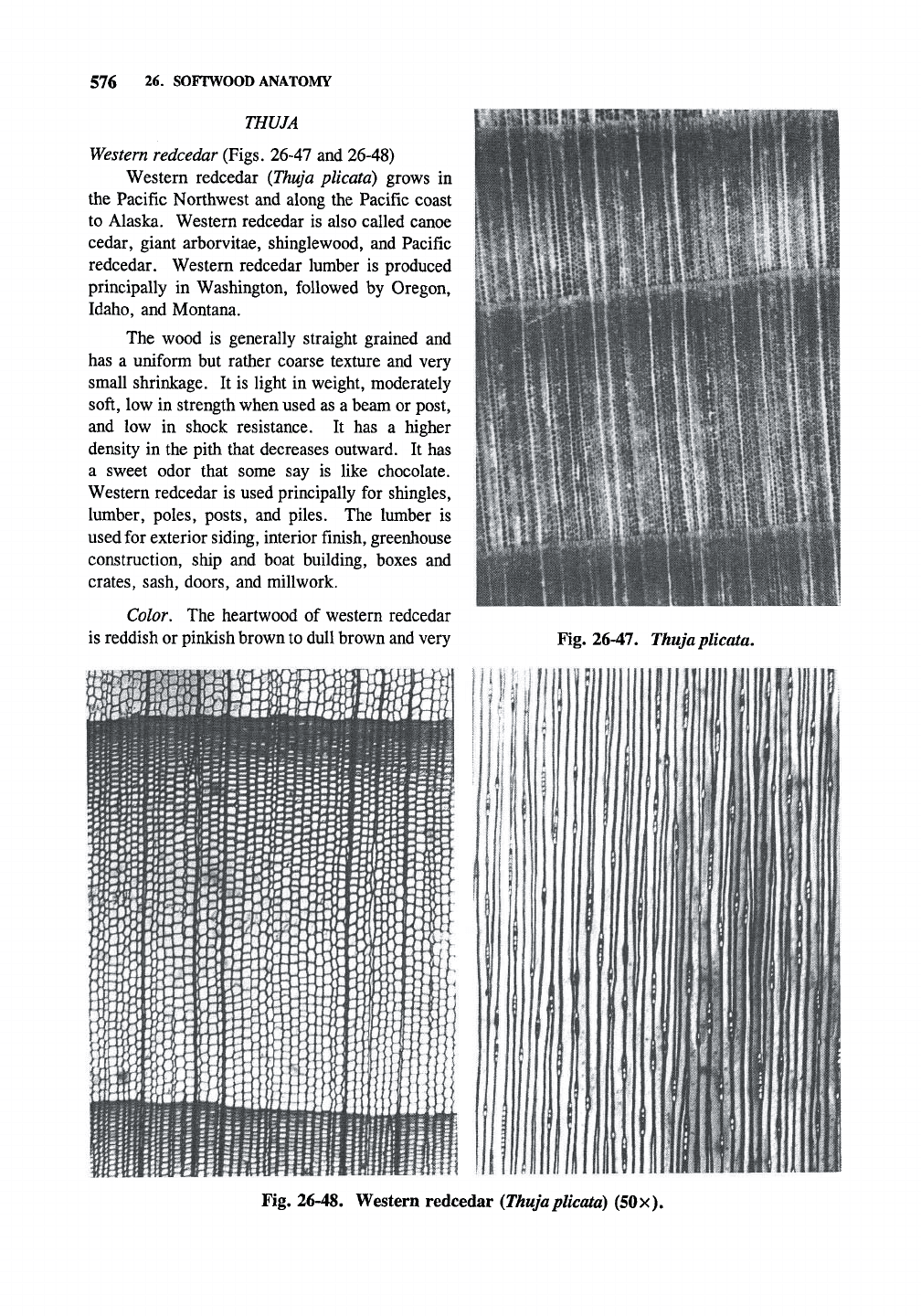
576 26. SOFTWOOD ANATOMY
THUJA
Western redcedar (Figs. 26-47 and 26-48)
Western redcedar {Thuja plicata) grows in
the Pacific Northwest and along the Pacific coast
to Alaska. Western redcedar is also called canoe
cedar, giant arborvitae, shinglewood, and Pacific
redcedar. Western redcedar lumber is produced
principally in Washington, followed by Oregon,
Idaho, and Montana.
The wood is generally straight grained and
has a uniform but rather coarse texture and very
small shrinkage. It is light in weight, moderately
soft, low in strength when used as a beam or post,
and low in shock resistance. It has a higher
density in the pith that decreases outward. It has
a sweet odor that some say is like chocolate.
Western redcedar is used principally for shingles,
lumber, poles, posts, and piles. The lumber is
used for exterior siding, interior finish, greenhouse
construction, ship and boat building, boxes and
crates,
sash, doors, and millwork.
Color. The heartwood of western redcedar
is reddish or pinkish brown to dull brown and very
Fig. 26-47. Thuja plicata.
Fig. 26-48. Western redcedar {Thujaplicata) (50
x).
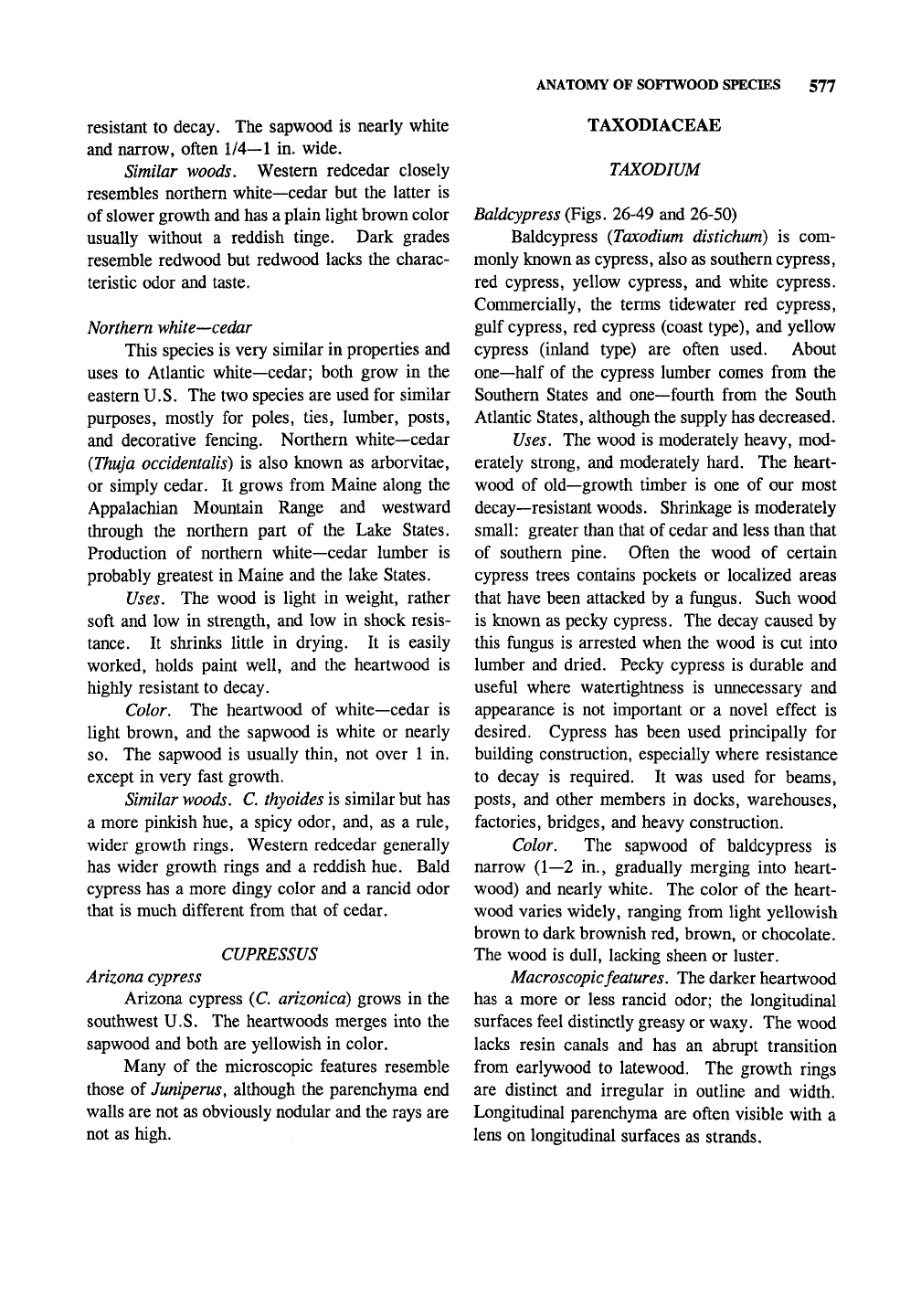
ANATOMY OF SOFTWOOD SPECIES 577
resistant to decay. The sapwood is nearly white
and narrow, often 1/4—1 in. wide.
Similar woods. Western redcedar closely
resembles northern white—cedar but the latter is
of slower growth and has a plain light brown color
usually without a reddish tinge. Dark grades
resemble redwood but redwood lacks the charac-
teristic odor and taste.
Northern white—cedar
This species is very similar in properties and
uses to Atlantic white—cedar; both grow in the
eastern
U.S.
The two species are used for similar
purposes, mostly for poles, ties, lumber, posts,
and decorative fencing. Northern white—cedar
(Thuja occidentalis) is also known as arborvitae,
or simply cedar. It grows from Maine along the
Appalachian Mountain Range and westward
through the northern part of the Lake States.
Production of northern white—cedar lumber is
probably greatest in Maine and the lake States.
Uses. The wood is light in weight, rather
soft and low in strength, and low in shock resis-
tance. It shrinks little in drying. It is easily
worked, holds paint well, and the heartwood is
highly resistant to decay.
Color. The heartwood of white—cedar is
light brown, and the sapwood is white or nearly
so.
The sapwood is usually thin, not over 1 in.
except in very fast growth.
Similar
woods.
C. thyoides is similar but has
a more pinkish hue, a spicy odor, and, as a rule,
wider growth rings. Western redcedar generally
has wider growth rings and a reddish hue. Bald
cypress has a more dingy color and a rancid odor
that is much different from that of cedar.
CUPRESSUS
Arizona cypress
Arizona cypress (C arizonica) grows in the
southwest U.S. The heartwoods merges into the
sapwood and both are yellowish in color.
Many of the microscopic features resemble
those of Juniperus, although the parenchyma end
walls are not as obviously nodular and the rays are
not as high.
TAXODIACEAE
TAXODIUM
Baldcypress (Figs. 26-49 and 26-50)
Baldcypress (Jaxodium distichum) is com-
monly known as cypress, also as southern cypress,
red cypress, yellow cypress, and white cypress.
Commercially, the terms tidewater red cypress,
gulf cypress, red cypress (coast type), and yellow
cypress (inland type) are often used. About
one—half of the cypress lumber comes from the
Southern States and one—fourth from the South
Atlantic States, although the supply has decreased.
Uses. The wood is moderately heavy, mod-
erately strong, and moderately hard. The heart-
wood of old—growth timber is one of our most
decay—resistant woods. Shrinkage is moderately
small: greater than that of cedar and less than that
of southern pine. Often the wood of certain
cypress trees contains pockets or localized areas
that have been attacked by a fungus. Such wood
is known as pecky cypress. The decay caused by
this fungus is arrested when the wood is cut into
lumber and dried. Pecky cypress is durable and
useful where watertightness is unnecessary and
appearance is not important or a novel effect is
desired. Cypress has been used principally for
building construction, especially where resistance
to decay is required. It was used for beams,
posts,
and other members in docks, warehouses,
factories, bridges, and heavy construction.
Color. The sapwood of baldcypress is
narrow (1—2 in., gradually merging into heart-
wood) and nearly white. The color of the heart-
wood varies widely, ranging from light yellowish
brown to dark brownish red, brown, or chocolate.
The wood is dull, lacking sheen or luster.
Macroscopic features. The darker heartwood
has a more or less rancid odor; the longitudinal
surfaces feel distinctly greasy or waxy. The wood
lacks resin canals and has an abrupt transition
from earlywood to latewood. The growth rings
are distinct and irregular in outline and width.
Longitudinal parenchyma are often visible with a
lens on longitudinal surfaces as strands.

578 26. SOFTWOOD ANATOMY
Similar
woods.
Cypress has a high degree of
variability. It resembles the cedars, but the odor
is entirely different. Some species of Cupressus
spp.
of the western U.S. are called cypress, but
are much different from bald cypress.
SEQUOIA
Redwood (Figs. 26-51 and 26-52)
Redwood {Sequoia sempervirens) is a very
large tree growing on the coast of northern Cali-
fornia. Another sequoia, giant sequoia {Sequoia
gigantea),
grows in a limited area in the Sierra
Nevada of California, but is used in very limited
quantities. Other names for redwood are coast
redwood, California redwood, and sequoia.
Production of redwood lumber is limited to Cali-
fornia, but a nationwide market exists.
Uses. Typical old—growth redwood is
moderately light in weight, moderately strong and
stiff,
and moderately hard. The wood is easy to
work, generally straight grained, and shrinks and
swells comparatively little. The heartwood has
high decay resistance. Redwood lumber is used
for building. It is remanufactured extensively into
Fig. 26-49.
Taxodium
distichum.
/llAHIIli Sif
Fig. 26-50. Baldcypress
{Taxodium distichum)
(50x).

ANATOMY OF SOFTWOOD SPECIES 579
siding, sash, doors, blinds, finish, casket stock,
and containers. Because of its durability, it is
useful for cooling towers, tanks, silos,
wood—stave pipe, and outdoor furniture. It is
used in agriculture for buildings and equipment.
Its use as timbers and large dimension in bridges
and trestles is relatively minor. The wood splits
readily and the manufacture of split products
(posts and fence material) is an important business
in the redwood area. Some redwood decorative
veneer is used.
Color. The unique color of redwood heart-
wood varies from a light cherry to a dark mahoga-
ny and distinguishes it from baldcypress. The
narrow sapwood (1—3 in.) is almost white.
Macroscopic features. The wood is without
normal resin canals and has no distinctive odor,
taste,
or feel. The wood is coarse—textured. The
transition to the narrow, dark latewood is abrupt.
Western redcedar heartwood may approach red-
wood in color, but the odor of the former is
distinct. The longitudinal parenchyma are visible
on longitudinal surfaces with a lens as strands.
Microscopic features. Bi— or triseriate
Fig.
26-51.
Sequoia sempervirens.
Fig. 26-52. Coast redwood
(Sequoia sempervirens)
(50x).
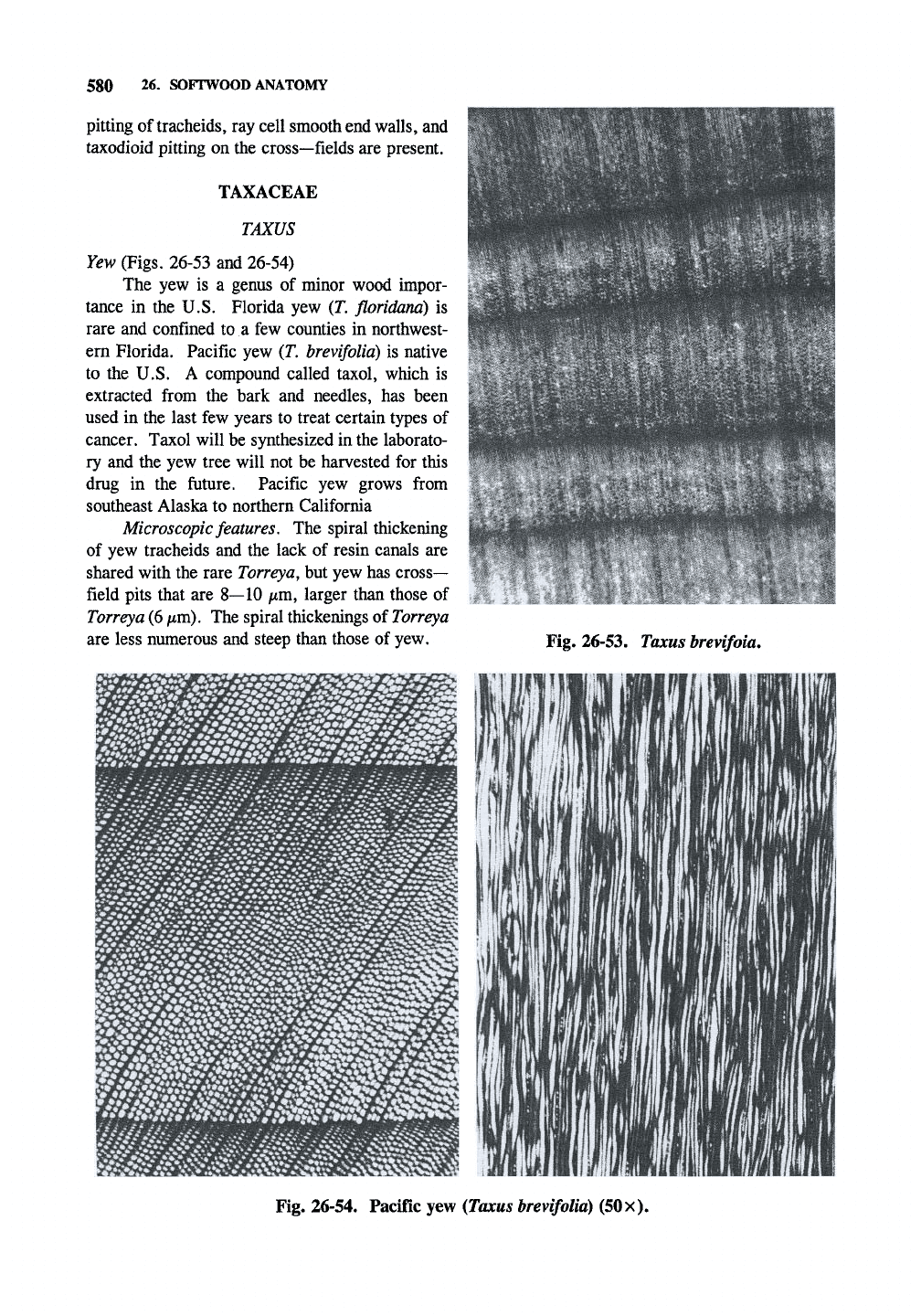
580 26. SOFTWOOD ANATOMY
pitting of
tracheids,
ray cell smooth end walls, and
taxodioid pitting on the cross—fields are present.
TAXACEAE
TAXUS
Yew (Figs. 26-53 and 26-54)
The yew is a genus of minor wood impor-
tance in the U.S. Florida yew (T. floridana) is
rare and confined to a few counties in northwest-
em Florida. Pacific yew {T. hrevifolia) is native
to the U.S. A compound called taxol, which is
extracted from the bark and needles, has been
used in the last few years to treat certain types of
cancer. Taxol will be synthesized in the laborato-
ry and the yew tree will not be harvested for this
drug in the future. Pacific yew grows from
southeast Alaska to northern California
Microscopic features. The spiral thickening
of yew tracheids and the lack of resin canals are
shared with the rare Torreya, but yew has cross-
field pits that are 8—10 /xm, larger than those of
Torreya (6
ptm).
The spiral thickenings of
Torreya
are less numerous and steep than those of yew.
Fig. 26-53. Taxus hrevifoia.
Fig. 26-54. Pacific yew {Taxus hrevifolia) (50x).
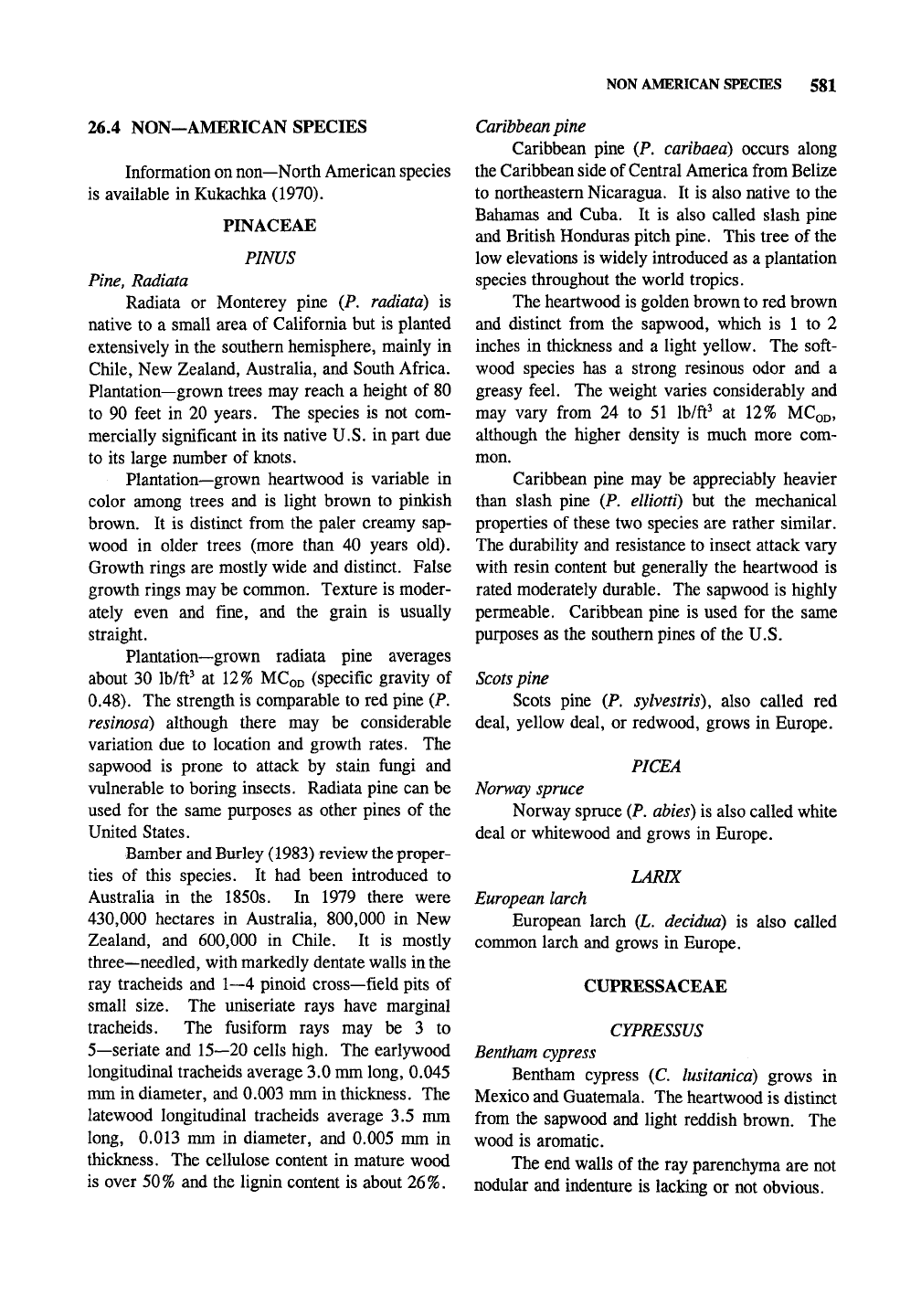
NON AMERICAN SPECIES 581
26.4 NON-AMERICAN SPECIES
Information on non—North American species
is available in Kukachka (1970).
PINACEAE
PINUS
Pine, Radiata
Radiata or Monterey pine (P. radiata) is
native to a small area of California but is planted
extensively in the southern hemisphere, mainly in
Chile, New Zealand, Australia, and South Africa.
Plantation—grown trees may reach a height of 80
to 90 feet in 20 years. The species is not com-
mercially significant in its native U.S. in part due
to its large number of knots.
Plantation—grown heartwood is variable in
color among trees and is light brown to pinkish
brown. It is distinct from the paler creamy sap-
wood in older trees (more than 40 years old).
Growth rings are mostly wide and distinct. False
growth rings may be common. Texture is moder-
ately even and fme, and the grain is usually
straight.
Plantation—grown radiata pine averages
about 30 Ib/ft^ at 12%
MCQD
(specific gravity of
0.48). The strength is comparable to red pine (P.
resinosa) although there may be considerable
variation due to location and growth rates. The
sapwood is prone to attack by stain fungi and
vulnerable to boring insects. Radiata pine can be
used for the same purposes as other pines of the
United States.
Bamber and Burley (1983) review the proper-
ties of this species. It had been introduced to
Australia in the 1850s. In 1979 there were
430,000 hectares in Australia, 800,000 in New
Zealand, and 600,000 in Chile. It is mostly
three—needled, with markedly dentate walls in the
ray tracheids and 1—4 pinoid cross—field pits of
small size. The uniseriate rays have marginal
tracheids. The fusiform rays may be 3 to
5—seriate and 15—20 cells high. The earlywood
longitudinal tracheids average 3.0 mm long, 0.045
mm in diameter, and 0.003 mm in thickness. The
latewood longitudinal tracheids average 3.5 mm
long, 0.013 mm in diameter, and 0.005 mm in
thickness. The cellulose content in mature wood
is over 50% and the lignin content is about 26%.
Caribbean
pine
Caribbean pine (P. caribaea) occurs along
the Caribbean side of Central America from Belize
to northeastern Nicaragua. It is also native to the
Bahamas and Cuba. It is also called slash pine
and British Honduras pitch pine. This tree of the
low elevations is widely introduced as a plantation
species throughout the world tropics.
The heartwood is golden brown to red brown
and distinct from the sapwood, which is 1 to 2
inches in thickness and a light yellow. The soft-
wood species has a strong resinous odor and a
greasy feel. The weight varies considerably and
may vary from 24 to 51 Ib/ft^ at 12% MCQD,
although the higher density is much more com-
mon.
Caribbean pine may be appreciably heavier
than slash pine (P. elliotti) but the mechanical
properties of these two species are rather similar.
The durability and resistance to insect attack vary
with resin content but generally the heartwood is
rated moderately durable. The sapwood is highly
permeable. Caribbean pine is used for the same
purposes as the southern pines of the U.S.
Scots
pine
Scots pine (P. sylvestris), also called red
deal, yellow deal, or redwood, grows in Europe.
PICEA
Norway spruce
Norway spruce (P. abies) is also called white
deal or whitewood and grows in Europe.
LARIX
European
larch
European larch (L. decidua) is also called
common larch and grows in Europe.
CUPRESSACEAE
CYPRESSUS
Bentham
cypress
Bentham cypress (C. lusitanica) grows in
Mexico and Guatemala. The heartwood is distinct
from the sapwood and light reddish brown. The
wood is aromatic.
The end walls of the ray parenchyma are not
nodular and indenture is lacking or not obvious.
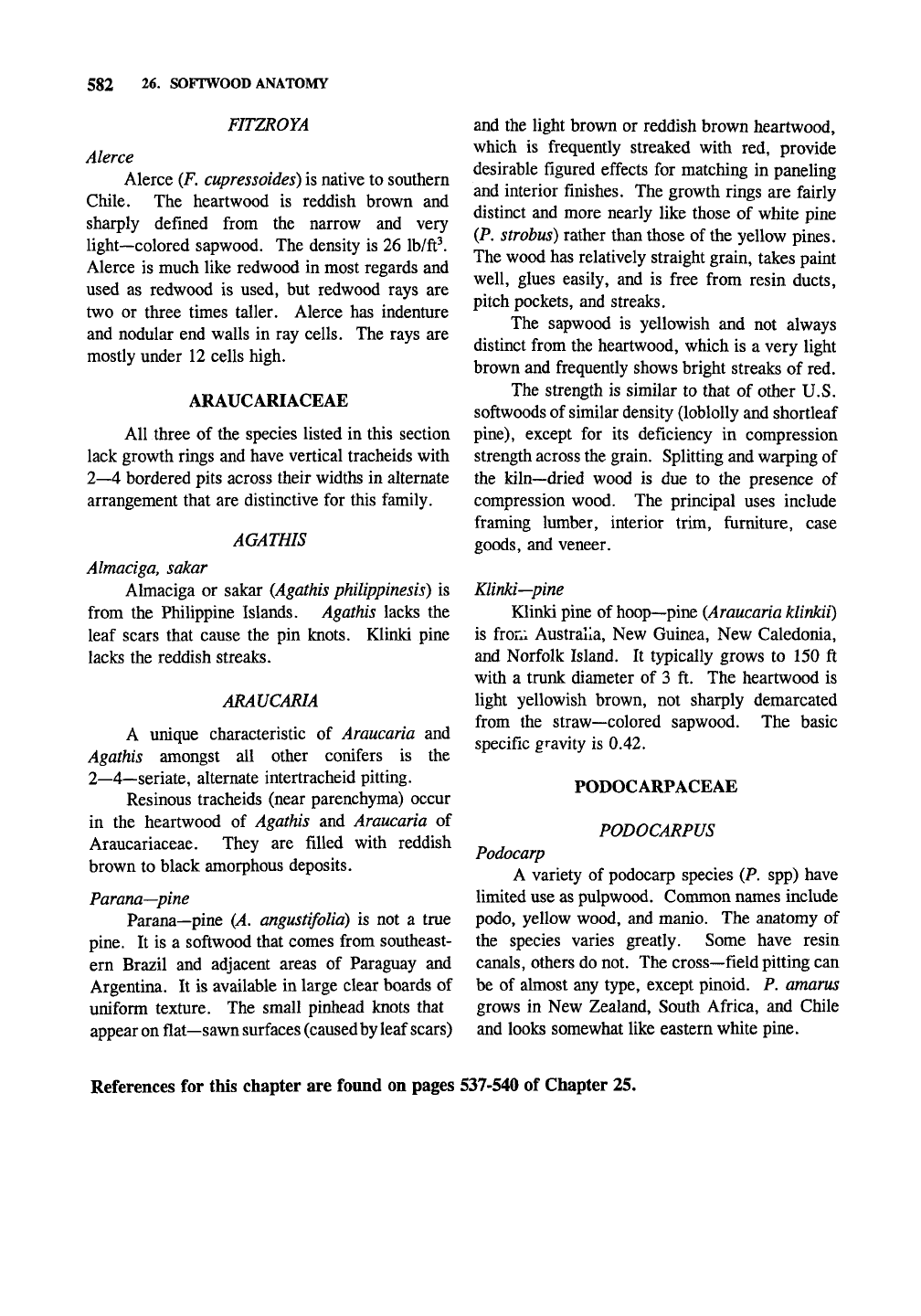
582 26. SOFTWOOD ANATOMY
FITZROYA
Alerce
Alerce (F.
cupressoides)
is native to southern
Chile. The heartwood is reddish brown and
sharply defined from the narrow and very
light—colored sapwood. The density is 26 Ib/ft^.
Alerce is much like redwood in most regards and
used as redwood is used, but redwood rays are
two or three times taller. Alerce has indenture
and nodular end walls in ray cells. The rays are
mostly under 12 cells high.
ARAUCARIACEAE
All three of the species listed in this section
lack growth rings and have vertical tracheids with
2—4 bordered pits across their widths in alternate
arrangement that are distinctive for this family.
AGATHIS
Almaciga, sakar
Almaciga or sakar
(Agathis philippinesis)
is
from the Philippine Islands. Agathis lacks the
leaf scars that cause the pin knots. Klinki pine
lacks the reddish streaks.
ARAVCARIA
A unique characteristic of Araucaria and
Agathis amongst all other conifers is the
2—4—seriate, alternate intertracheid pitting.
Resinous tracheids (near parenchyma) occur
in the heartwood of Agathis and Araucaria of
Araucariaceae. They are filled with reddish
brown to black amorphous deposits.
Parana—pine
Parana—pine (A. angustifolia) is not a true
pine.
It is a softwood that comes from southeast-
ern Brazil and adjacent areas of Paraguay and
Argentina. It is available in large clear boards of
uniform texture. The small pinhead knots that
appear
on
flat—sawn surfaces (caused
by
leaf scars)
and the light brown or reddish brown heartwood,
which is frequently streaked with red, provide
desirable figured effects for matching in paneling
and interior finishes. The growth rings are fairly
distinct and more nearly like those of white pine
(P.
strobus) rather than those of the yellow pines.
The wood has relatively straight grain, takes paint
well, glues easily, and is free from resin ducts,
pitch pockets, and streaks.
The sapwood is yellowish and not always
distinct from the heartwood, which is a very light
brown and frequently shows bright streaks of red.
The strength is similar to that of other U.S.
softwoods of similar density (loblolly and shortleaf
pine),
except for its deficiency in compression
strength across the grain. Splitting and warping of
the kiln—dried wood is due to the presence of
compression wood. The principal uses include
framing lumber, interior trim, furniture, case
goods, and veneer.
Klinki—pine
Klinki pine of hoop—pine
(Araucaria
klinkii)
is fron: Australia, New Guinea, New Caledonia,
and Norfolk Island. It typically grows to 150 ft
with a trunk diameter of 3 ft. The heartwood is
light yellowish brown, not sharply demarcated
from the straw—colored sapwood. The basic
specific gravity is 0.42.
PODOCARPACEAE
PODOCARPUS
Podocarp
A variety of podocarp species (P. spp) have
limited use as pulpwood. Common names include
podo,
yellow wood, and manio. The anatomy of
the species varies greatly. Some have resin
canals, others do not. The cross—field pitting can
be of almost any type, except pinoid. P. amarus
grows in New Zealand, South Africa, and Chile
and looks somewhat like eastern white pine.
References for this chapter are found on pages 537-540 of Chapter 25.
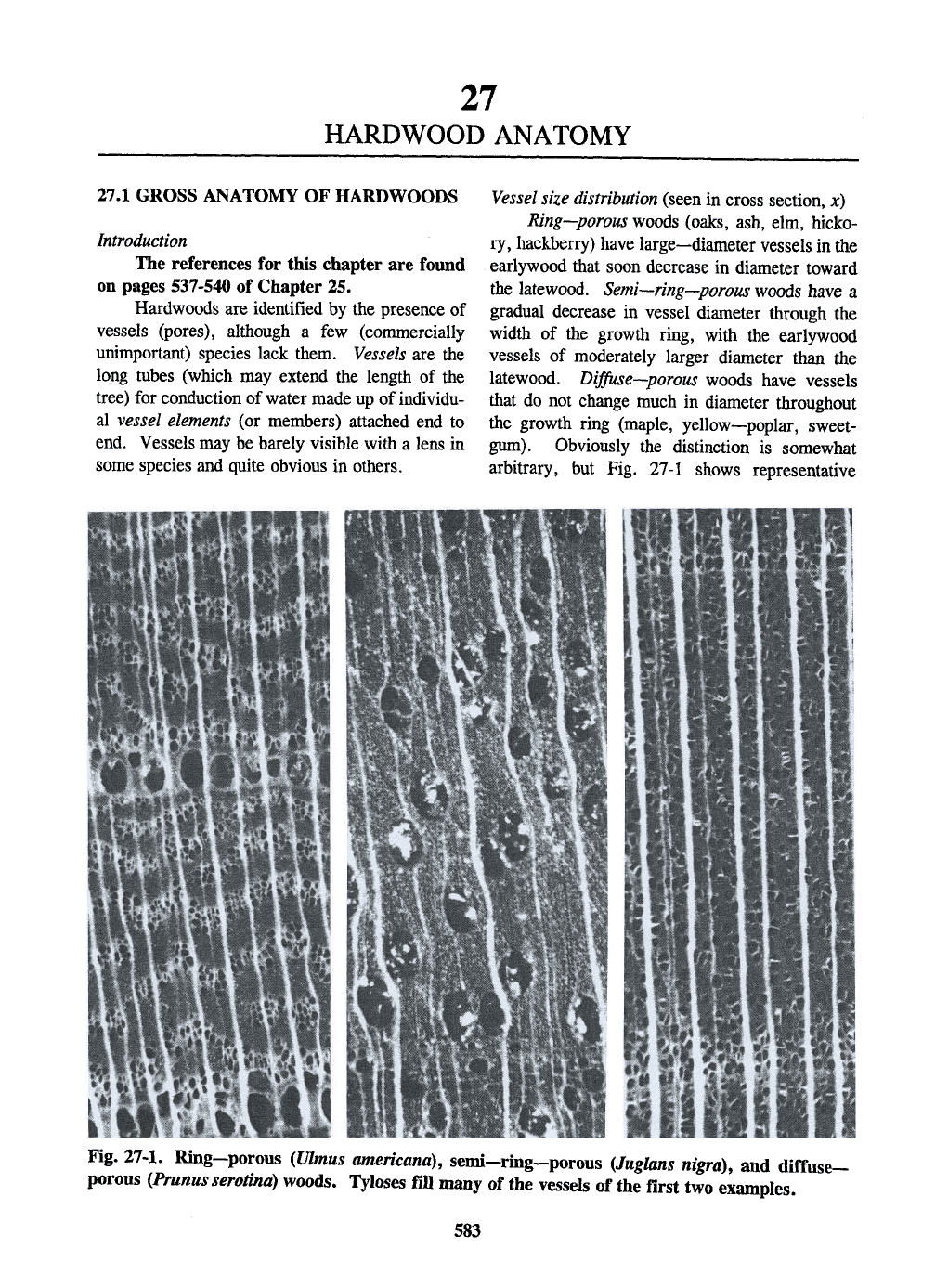
27
HARDWOOD ANATOMY
27.1 GROSS ANATOMY OF HARDWOODS
Introduction
The references for this chapter are found
on pages 537-540 of Chapter 25.
Hardwoods are identified by the presence of
vessels (pores), although a few (commercially
unimportant) species lack them. Vessels are the
long tubes (which may extend the length of the
tree) for conduction of water made up of individu-
al vessel elements (or members) attached end to
end. Vessels may be barely visible with a lens in
some species and quite obvious in others.
Vessel
size
distribution
(seen in cross section, x)
Ring—porous woods (oaks, ash, elm, hicko-
ry, hackberry) have large--diameter vessels in the
earlywood that soon decrease in diameter toward
the latewood.
Semi—ring—porous
woods have a
gradual decrease in vessel diameter through the
width of the growth ring, with the earlywood
vessels of moderately larger diameter than the
latewood. Diffuse—porous woods have vessels
that do not change much in diameter throughout
the growth ring (maple, yellow—poplar, sweet-
gum).
Obviously the distinction is somewhat
arbitrary, but Fig. 27-1 shows representative
Fig. 27-1. Rmg—porous {Ulmus americana), semi—rmg—porous (Juglans nigra), and diffuse-
porous (Prunusserotina) woods. Tyloses fiU many of the vessels of the first two examples.
583
